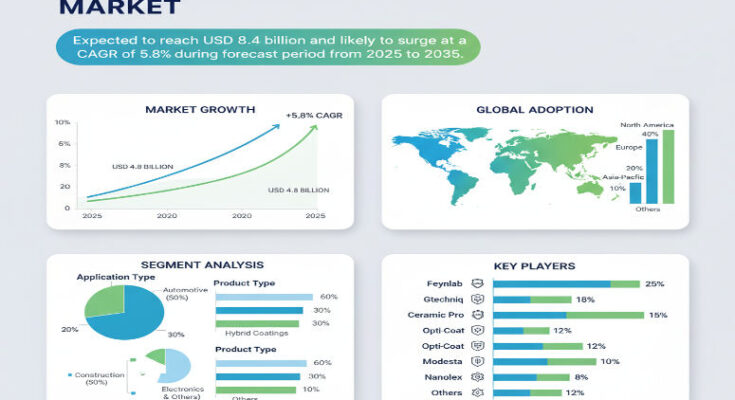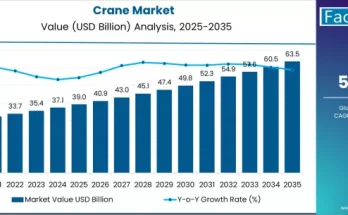The global nano ceramic coatings market is projected to grow from USD 4.8 billion in 2025 to USD 8.4 billion by 2035, showing a compound annual growth rate (CAGR) of 5.8% during the forecast period. This expansion is driven by increasing demand for high-performance protective coatings, enhanced durability and corrosion resistance, and growing adoption of nano-structured ceramic surfaces across automotive, industrial, aerospace, and equipment manufacturing sectors.
Market Drivers & Growth Catalysts
Demand for nano ceramic coatings is rising as manufacturers seek coatings with superior performance—providing wear resistance, thermal protection, chemical resistance, and hydrophobic or self-cleaning properties in harsh environments. Coating technologies using nanostructured ceramic particles or sol-gel-derived ceramic networks allow thinner, more uniform coatings with better adhesion, improved durability, and enhanced surface properties. Additionally, regulatory and operational pressures to increase equipment lifespan and reduce maintenance costs encourage adoption of coating solutions that extend service intervals and improve reliability.
Technology, Product & Application Segments
Nano ceramic coatings are applied using various technologies. Sol-gel ceramic coatings, which form ceramic layers from colloidal solutions, are among the leading technologies, offering good flexibility, strong adhesion, and uniform nano-scale structures. Other techniques include thermal spray or plasma methods that deposit ceramic layers on substrates, creating robust protective coatings for industrial components.
In terms of end uses, the automotive sector is a major application area, commanding a significant share of demand due to needs for protective coatings on vehicle components, exterior surfaces, and aftermarket protection. Other major application segments include industrial equipment, aerospace components, and other high-performance equipment requiring enhanced surface protection and thermal or wear resistance.
Regional Trends & Opportunity Hotspots
Regions such as North America, Europe, and Asia-Pacific are among the key growth markets. North America and Europe benefit from advanced manufacturing infrastructure, regulatory standards, aerospace industry demand, and automotive aftermarket adoption of premium protective coatings. Asia-Pacific is also a growing hotspot, driven by rapidly expanding automotive manufacturing, industrial equipment production, and surface treatment capacity. Growth in emerging manufacturing hubs and demand for durable, cost-effective coatings support adoption in more cost-sensitive regions as well.
Competitive Landscape & Strategic Developments
The competitive environment includes coating manufacturers, surface treatment specialists, nano-material suppliers, and system integrators. Key players are investing in research and development for advanced coating formulations, nano ceramic particles, better deposition processes, and enhancements in coating durability and performance. The market also sees partnerships between coating firms and OEMs to integrate nano ceramic coatings into production lines or aftermarket protective products.
Challenges & Market Restraints
Despite the favorable outlook, there are some constraints. The cost of advanced nano ceramic coating materials, deposition equipment, or application processes can be higher than conventional coatings. Achieving consistent nano-scale ceramic structures and maintaining coating uniformity across complex components requires precision, which can increase costs or complicate scaling. In some markets, adoption may be slower due to cost sensitivity or lack of awareness about the long-term benefits of nano ceramic coatings compared to standard coatings.
Forecast & Strategic Recommendations
With the market expected to almost double from USD 4.8 billion in 2025 to USD 8.4 billion by 2035, at a 5.8% CAGR, companies should focus on refining coating formulations for cost-effectiveness, expanding deposition or application capacities in fast-growing regions, and offering value-added coating services such as preparation, application, and post-treatment. Investing in modular coating application lines or offering coating as a service can help capture market share. Partnerships with industries such as automotive, aerospace, and industrial equipment manufacturers will help integrate coatings early in design or aftermarket protection strategies.
Browse Full Report: https://www.factmr.com/report/3295/nano-ceramic-coatings-market
Editorial Perspective
Nano ceramic coatings are emerging as essential enablers of enhanced durability, reduced maintenance, and improved performance in demanding applications. As industries push for longer equipment lifespans, lower downtime, and better surface protection, nano ceramic coatings will play an increasingly strategic role across sectors. Companies that combine material innovation, scalable application technologies, and strong regional presence will be best positioned to capitalize on the projected USD 8.4 billion market by 2035.



